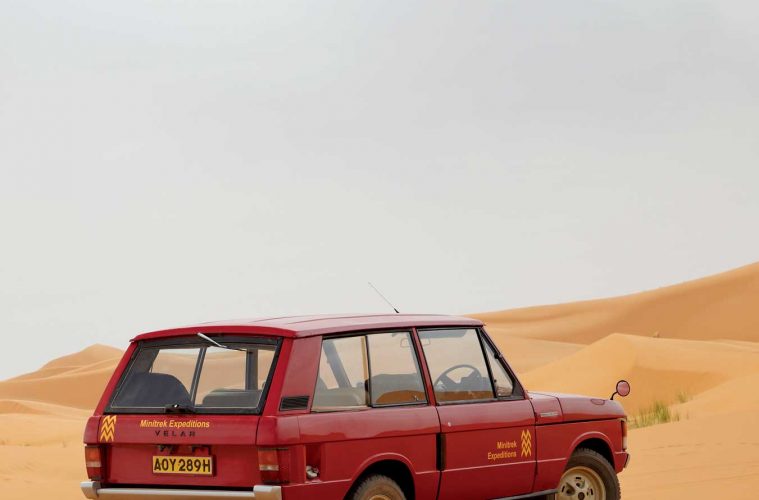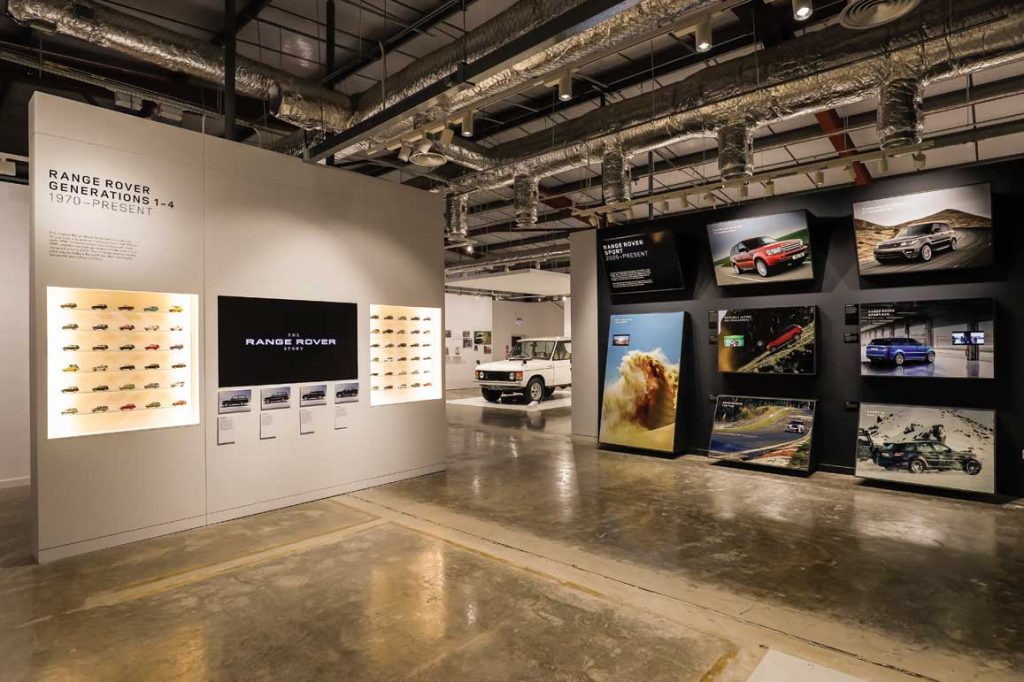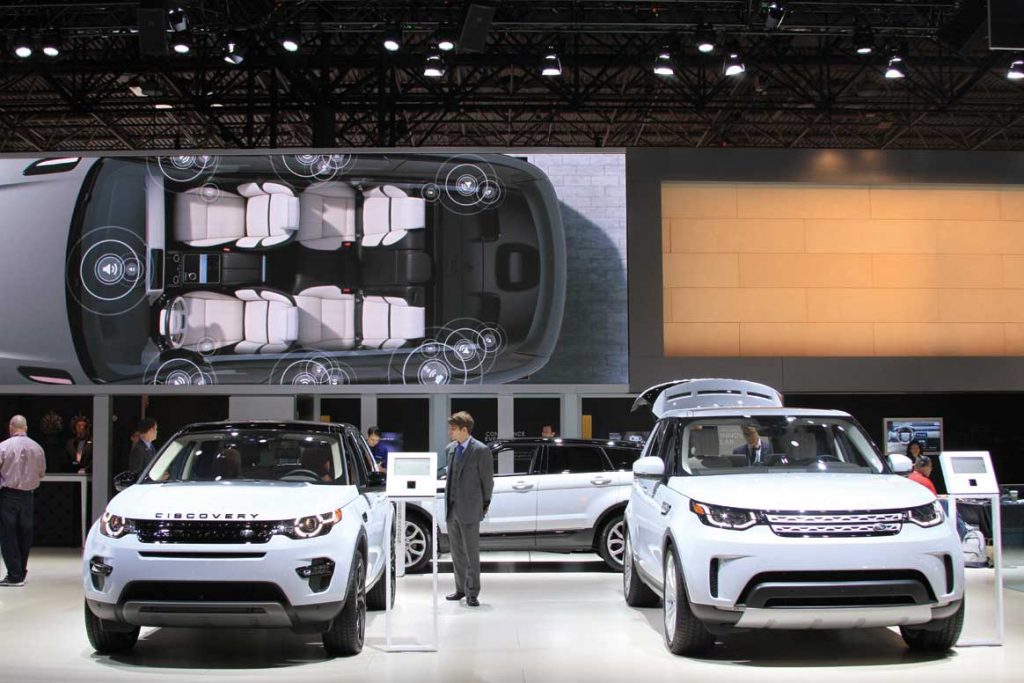In 1966, Spen King, then the head of New Vehicles Projects of the Rover Car Company, dusted off the concept of the abandoned “Road Rover.” King proposed to use long-travel coil springs for a multi-purpose 4×4. Peter Wilks authorized Land Rover engineer Geof Miller to lead the team and by 1967, the first prototype went under review. To evade nosy competitors and automotive journalists, a shell company, the Velar Car Company, was registered in London and the prototype carried the name “Velar” on their bonnets. In 1970, Rover launched the Range Rover to an appreciative world.
Land Rover has chosen the name Velar [“Velare” in Italian means “to veil” -ed.] for its newest member of the Range Rover clan. Its North American presentation came at this year’s New York International Auto Show; it will appear at Land Rover dealers this August as a 2018 model.
This historic name reappeared in concert with Land Rover launching its Range Rover Reborn project, which has begun the restoration of first generation two-door Range Rovers. So we dug back into the past and asked Land Rover legend Roger Crathorne to reflect on his time with the first Velars and share his memories with us.
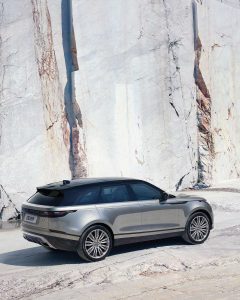 At the New York International Auto Show we spent time with Mark Burniston, Land Rover UK Vehicle Engineering Manager for the Velar, and Dave Larsen, the Product Planning Manager for Land Rover North America, to learn more about the newest Velar and its place in the Land Rover lineup.
At the New York International Auto Show we spent time with Mark Burniston, Land Rover UK Vehicle Engineering Manager for the Velar, and Dave Larsen, the Product Planning Manager for Land Rover North America, to learn more about the newest Velar and its place in the Land Rover lineup.
Land Rover also made it possible for us to meet with Dr. Ralf Speth, the CEO of Jaguar Land Rover, and Joe Eberhardt, the president/CEO of Land Rover North America, and one of the country’s newest Land Rover dealers, Jack Weidinger of Jaguar Land Rover Freeport.
It might have taken a half century for the Velar to re-emerge, but it was well worth the wait.
Roger Crathorne
[We reached out to Roger Crathorne, a decades-long Land Rover engineer who helped create the Defender Build Line Exhibit, for a look back at the original VELAR and its new sibling -ed.]
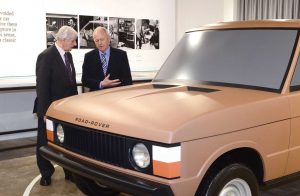 The inspiration for the Story of the Range Rover exhibit at Solihull came about when this newest generation of the Range Rover family needed a name. Jaguar Land Rover reached back to assign the original code name we used in 1967, when the first Range Rover prototype vehicle had to register for the road.
The inspiration for the Story of the Range Rover exhibit at Solihull came about when this newest generation of the Range Rover family needed a name. Jaguar Land Rover reached back to assign the original code name we used in 1967, when the first Range Rover prototype vehicle had to register for the road.
The name VELAR had been suggested by one of our car colleagues who was part of the Alvis Car Company, purchased by Rover to expand the vehicle car line. We created the fictitious company in Croydon, near London, with the hope that this would keep our prototype’s identity a secret from other manufacturers.
However, the initial inspiration to begin the design and development of the original Range Rover came from our North American Sales office. They asked if we could improve on the basic Land Rover Series II-A by increasing comfort and performance. Spen King, then the Director of Rover’s New Vehicle Projects, took up the challenge, along with his colleague Gordon Bashford. Spen had driven his Rover 2000 saloon car across a rough field and had the thought that he could use the same long travel coil springs when added to a Land Rover type chassis to improve the ride. The performance improvement came from the V8 engine that the Rover Company purchased from GM.
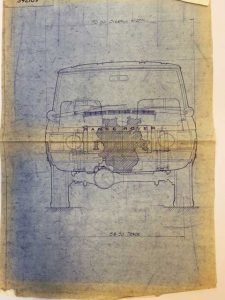 When the program came together, a small team of development engineers, headed up by Geof Miller, included Alan Wood and myself. I had just qualified, so I could not believe my luck in being selected for this new project. What an exciting time it was during the 1960s to work in the engineering department!
When the program came together, a small team of development engineers, headed up by Geof Miller, included Alan Wood and myself. I had just qualified, so I could not believe my luck in being selected for this new project. What an exciting time it was during the 1960s to work in the engineering department!
The original project name was “Alternative Station Wagon” and a lot of the work was very much aligned to create a vehicle that would sell in the USA (shame it took 16 years to get the vehicle ready.) Once the first prototype was produced, it was then given its engineering identification as the 100″ Station Wagon. This reflected the wheelbase of the vehicle; all Land Rover products of the period were identified by their wheelbase. Once the vehicle’s design was worked on in the styling studio and the final style was approved, one of the designers came up with the name Range Rover.
Development work carried on for three years and the first vehicle came down the production line towards the end of 1969, after only building and testing seven prototypes. Prototype One carried a VELAR badge on the front grill. This was a one-off of this style of badge which I have in my collection; after the vehicle was scrapped I saved the badge along with many other things Land Rover.
The badge is exhibited in this new Customer Experience Tour along with several other items from my engineering tools, slide rule, calculator and micrometer. This exhibit will take you through the whole history of Range Rover to date, from the first VELAR to the new Range Rover Velar at the end.
Mark Buriston
Vehicle Engineering Manager, Range Rover Velar
 “When he designed the first Range Rover, Charles Spencer King had in his mind a concept for a car that would be appropriate in any number of places, from transporting farm animals to conveying himself and his good lady for a night out. I met him in the early 2000s, when he spoke at Gaydon. I know that he was very intelligent and it wouldn’t be without accident that he chose the name ‘Velar’ for the prototype. I can imagine him at his desk, creating the name from the letters in L-A-N-D-R-O-V-E-R.”
“When he designed the first Range Rover, Charles Spencer King had in his mind a concept for a car that would be appropriate in any number of places, from transporting farm animals to conveying himself and his good lady for a night out. I met him in the early 2000s, when he spoke at Gaydon. I know that he was very intelligent and it wouldn’t be without accident that he chose the name ‘Velar’ for the prototype. I can imagine him at his desk, creating the name from the letters in L-A-N-D-R-O-V-E-R.”
Mark Buriston entered Land Rover under a student program along with Nick Rogers, now the head of the Range Rover program. As befits Land Rover’s evolving corporate history, they found themselves near the end of the British Leyland years assigned to the Morris works at Cowley. Mark would later become the chief engineer for the Freelander monocoque chassis; while he admits the engines that came here could be “ropey,” the Freelander proved very successful for Land Rover in other markets and the Freelander II [LR2] proved very capable here.
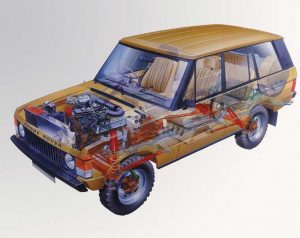 With the Velar, “We were challenged by [Design Chief] Gerry McGovern with a shallow headlight line, to help create a CD [drag coefficient] of only .32, yet be fully recognizable as a Range Rover. Many of the lines of the Velar exist because of the need for aerodynamics. The door handles recess into the door itself, as with the original Range Rover, so as to improve aerodynamics and reduce wind noise. But we know the conditions in which a Land Rover is used, so we’ve designed the door handle motors to burst through 4 mm of ice build-up if necessary. We’ve used the same family of wheel and tire combinations, from 18-22 inches, as with the LR4. The larger wheels do mate well with proportions of the Velar.”
With the Velar, “We were challenged by [Design Chief] Gerry McGovern with a shallow headlight line, to help create a CD [drag coefficient] of only .32, yet be fully recognizable as a Range Rover. Many of the lines of the Velar exist because of the need for aerodynamics. The door handles recess into the door itself, as with the original Range Rover, so as to improve aerodynamics and reduce wind noise. But we know the conditions in which a Land Rover is used, so we’ve designed the door handle motors to burst through 4 mm of ice build-up if necessary. We’ve used the same family of wheel and tire combinations, from 18-22 inches, as with the LR4. The larger wheels do mate well with proportions of the Velar.”
“The Velar is narrower and stands two inches shorter than the Range Rover Sport. It’s oriented towards an on-road environment, but it’s retained a Land Rover all terrain capability. We’ve designed it to have 10” of ground clearance, a class-leading three feet of wading depth, and 29-degree approach and departure angles. I’m proud of its off-road performance. We’ve tackled all the Eastnor Castle off-road challenges and run it through the Middle East and Scandinavian arctic for extremes of driving conditions.”
“It’s stunningly appropriate that we’ve introduced it at this New York Auto Show, as metropolitan New York is the largest market in the world for the Range Rover models.”
“The entry level Velar comes with a coil sprung suspension and the 2.0 liter Ingenium 4-cylinder petrol sith 180 hp and 317 ft. lbs of torque. It goes nought to 60 in 8.4 seconds. The petrol version offers 247 hp and 269 ft lbs of torque, with nought to 60 in 6.4 seconds. If you need more power, the V6 with 380 hp and 332 ft. lbs of torque will send you to 60 mph in 5.3 seconds.
The Velar features Intelligent Driveline Dynamics, which allows a single-speed transfer case to select one of the nine gears, using Terrain Response, to engage the 4-wheel drive within 200 milliseconds. Power goes permanently to the rear axle with an instantaneous clutch engagement to the front axle when driving conditions call for it. And if you select the V6 option, you can get a locking differential.”
“If Spen King were designing Land Rovers right now, I believe that he would be designing them as we do right now. With the original Range Rover, he sought ways to have variable dampening in every direction, for plushness in normal use and tautness when driving conditions required it. And, of course, the use of the best technology to offer the most capable off-road experience. The Velar demonstrates that his ideals are still in place.”
Dave Larson
Product Planning Manager, Jaguar Land Rover North America
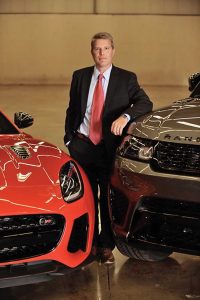 While Dave Larson started with JLR only two years ago, he’s a quarter-century veteran of the automotive industry. “When I chose to join Jaguar Land Rover, it was the models in the pipeline that really drew me to the company.”
While Dave Larson started with JLR only two years ago, he’s a quarter-century veteran of the automotive industry. “When I chose to join Jaguar Land Rover, it was the models in the pipeline that really drew me to the company.”
“Needless to say, I’m very excited about the re-introduction of the Discovery. We’re not calling it the Discovery 5, just Discovery. The replacement for the LR4 had to remain true to the capabilities of the marque, and if anything, its off-road capabilities are actually enhanced. During the one wave of the press launch in the southwest, we ran into a blizzard and found a semi off the highway. The Discovery—a totally stock one—pulled it back onto the road!”
“The Discovery represents versatility with a family focus. I have four kids and they’re always fighting over charging their electronic devices. The large number of USB charging outlets, and a WiFi system that can support nine devices—these features matter with a large family today. On Discovery, the lift rear tailgate gives terrific accessibility—and that clever interior seating for tailgating… I live on a hill and when I come home from a store, it’s much easier to remove stuff.”
“The next generation infotainment system reacts quickly and intuitively to commands, thanks to its Quad Core processor. I know that buyers will also find the InControl phone apps for seat placement, starting, parking spot searches and more really helpful. I’m also pleased that the design team made use of every possible available space in the vehicle.”
Dealers will receive one Discovery as a demonstrator, with a May 23rd launch date for this new addition to a distinguished family.
When asked, Dave said, “A winch kit is being evaluated. We’re always looking at assessing needs for adding new products.”
Dave was also understandably chuffed about the Range Rover Velar. “The Velar is the new design language, and gives elements of what other Range Rover models will look like as we refresh and/or redesign in the future. It fills a gap between the Evoque and Range Rover Sport. It’s slightly shorter and lower than the Sport, but retains the Range Rover off-road capability. Its focus is on on-road performance, which can be met with either a 2.0 petrol or diesel engine, or the supercharged V6. But it will still tow up to 5,500 pounds.” Diesel sales of Range Rovers are about 15% of the total to date, and he anticipates that it would be about the same for the Velar. Dealers should expect to receive a demonstrator soon with general sales beginning in August, a good time to launch a 2018 model.
As always when interviewing Land Rover executives, the subject of the new Defender comes up. “Land Rover has kept the name and will introduce a new Defender,” Dave said. “No timeline has been announced yet.”
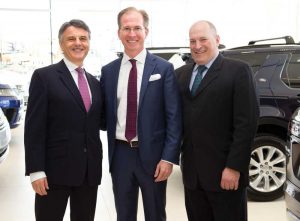
Dr. Ralf Speth, CEO, Jaguar Land Rover
Joe Eberhart, President and CEO, Jaguar Land Rover North America
Jack Weidinger, Dealer Principal, Jaguar Land Rover Freeport
[Jaguar Land Rover arranged for a press discussion with Land Rover executives at the new dealership in Freeport, NY. Here are some excerpts from that roundtable -ed.]
Q: I know that this is awkward, but I must ask this question on behalf of our readers—what can you tell them about the upcoming Defender?
Dr. Speth: “The Defender is an icon, and we are working very hard on the successor. Regulations in markets around the world require that we modernize the Defender to incorporate design features that buyers today expect in any vehicle. These new features will make it very capable in all situations.”
“Jaguar Land Rover is really taking care of its heritage through our Classic Center. We enjoy tremendous brand loyalty, and I see our Classic marque programs becoming ever more important. We really like the richness of our heritage vehicles.”
Q: With Jaguar and Land Rover under one corporate roof, how do you distinguish between the two marques as Jaguar adds an SUV?
 Dr. Speth: “Land Rover and Jaguar do share some design and engineering thrusts, but their DNA is fixed by their marques. And when the DNA is fixed, it can only turn out one way. We make certain that the design and engineering elements are precisely defined; if Jaguar’s elements are art and driving experience, Land Rover’s is all about capability. We might use the same aluminum, seek the best weight balance and steering feel in Jaguar and Land Rover, but in the end, you will feel the difference when driving an example of each marque.”
Dr. Speth: “Land Rover and Jaguar do share some design and engineering thrusts, but their DNA is fixed by their marques. And when the DNA is fixed, it can only turn out one way. We make certain that the design and engineering elements are precisely defined; if Jaguar’s elements are art and driving experience, Land Rover’s is all about capability. We might use the same aluminum, seek the best weight balance and steering feel in Jaguar and Land Rover, but in the end, you will feel the difference when driving an example of each marque.”
“We work with the heritage of each marque when we design new models, but the vehicles must be right for our dealers worldwide.”
Q: Why are Land Rover dealerships changing their appearance?
Joe Eberhardt: “Jaguar Land Rover has moved to have more dealerships combine the sales and service of both marques in one location and have dealerships worldwide share a common appearance. The new ‘Arch Concept’ links the two marques through a common entrance; stand-alone dealerships will incorporate the same design. The ‘Arch Concept’ was introduced in the rest of the world in 2015, so we’re a little behind here in the US. Many dealers had already been updated in the recent past, but we anticipate that all will incorporate this new architecture by 2023. Jaguar Land Rover Darien [CT] opened the first one and Jaguar Land Rover Freeport is the fifth in the US; Salt Lake City, Grand Rapids, MI, New York City and Fairfield, CT, are underway and will re-open soon.”
Jack Weidinger: “While this dealership is new to Land Rover, my family company has been selling Jaguars longer than any other franchise in the US. My grandfather started with Jaguar in 1938, and after World War II, any dealer willing to add imported cars to their inventory could become a dealer. My family has always taken pride in our affiliation with Jaguar. With this new building we’re bringing Land Rover back to the Long Island’s South Shore for the first time in a decade.”
“The Arch Concept required quite an investment; the architectural instructions from Jaguar Land Rover UK ran 400 pages. We also added our own ideas. We can park up to 100 vehicles on our roof. Our service area is glass-walled so customers can see our technicians at work. I’ve always taken pride in our service department. The tiled floors are cleaned constantly, and our technicians have the time to clean their tools after a service job.”
“I am a huge classic car fan as I grew up around Jaguars. When my father passed away I took over his 15-car collection that I enjoy and use. I’ll take any one of them to classic car shows and events. In our shop right now, I still have a Jaguar XKE Series III V-12 that our shop restored seven years ago.”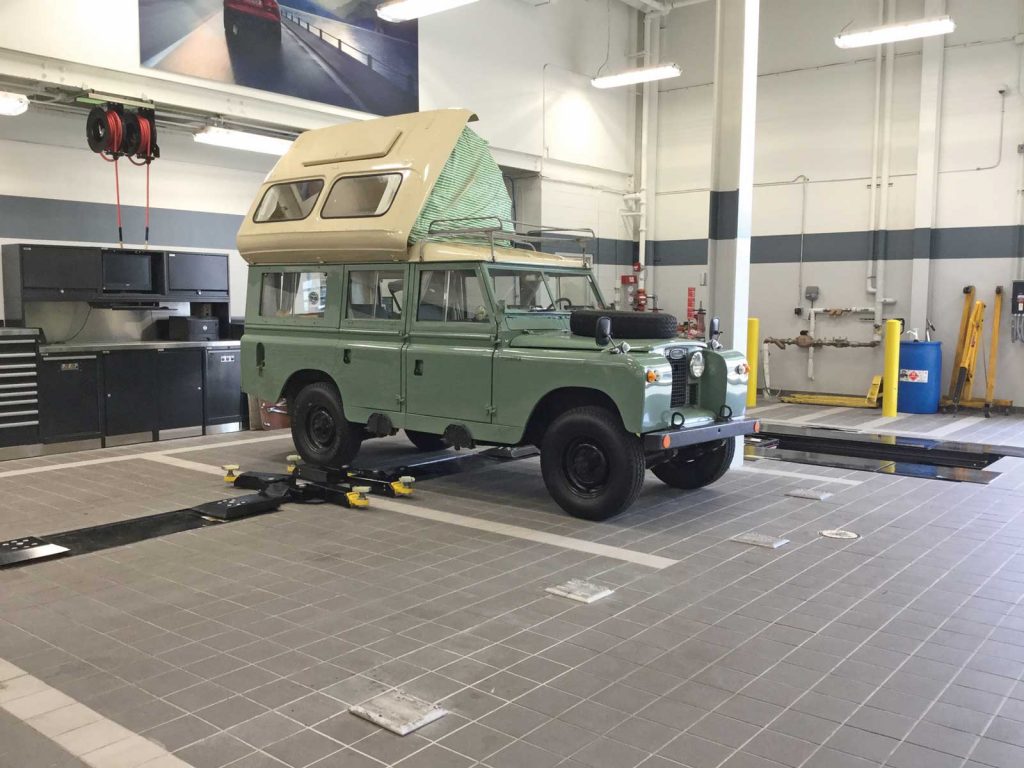
“I have always loved the Series and Defender models. I’d been looking for a long time, and as I got closer to the dealership taking on Land Rover, I wanted to find one. NAS Defender 90s certainly appealed to me, but as I’m very comfortable around old British cars, I thought of a Series Land Rover. I preferred to find a 109” and was thrilled to purchase this Dormobile, which was refurbished back in the 1980s. You don’t even have to know a lot about Land Rovers to see that it’s authentic. I’ve even ordered a reproduction wardrobe cabinet for the rear.”
“I’m sure it will spend some time on our showroom floor; I want to show people that we’re really enthusiasts here, and that we’re proud of Land Rover’s heritage, too.”
By Jeffrey Aronson
Photos: Land Rover Media, Roger Crathorne, Jeffrey Aronson, Andres Catana
